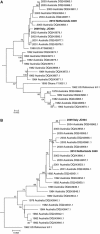The first complete genome sequences of clinical isolates of human coronavirus 229E
- PMID: 22926811
- PMCID: PMC7088690
- DOI: 10.1007/s11262-012-0807-9
The first complete genome sequences of clinical isolates of human coronavirus 229E
Abstract
Human coronavirus 229E has been identified in the mid-1960s, yet still only one full-genome sequence is available. This full-length sequence has been determined from the cDNA-clone Inf-1 that is based on the lab-adapted strain VR-740. Lab-adaptation might have resulted in genomic changes, due to insufficient pressure to maintain gene integrity of non-essential genes. We present here the first full-length genome sequence of two clinical isolates. Each encoded gene was compared to Inf-1. In general, little sequence changes were noted, most could be attributed to genetic drift, since the clinical isolates originate from 2009 to 2010 and VR740 from 1962. Hot spots of substitutions were situated in the S1 region of the Spike, the nucleocapsid gene, and the non-structural protein 3 gene, whereas several deletions were detected in the 3'UTR. Most notable was the difference in genome organization: instead of an ORF4A and ORF4B, an intact ORF4 was present in clinical isolates.
Figures
References
-
- http://www.ictvonline.org/virusTaxonomy.asp?version52009&bhcp51. Accessed May 2012
-
- van der Hoek L. Antivir. Ther. 2007;12:651–658. - PubMed
Publication types
MeSH terms
Substances
LinkOut - more resources
Full Text Sources
Other Literature Sources
Miscellaneous


